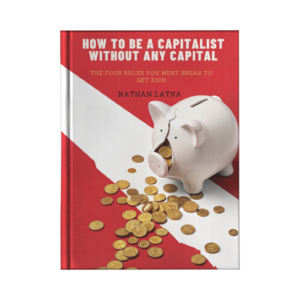
Book Summary: Profit First by Mike Michalowicz
January 11, 2025
Book Summary: Good to great by Jim Collins
January 18, 2025Nathan Latka’s How to Be a Capitalist Without Any Capital offers practical, contrarian strategies for achieving financial freedom, even if you’re starting from scratch. In this article, we summarize the key insights from this transformative book, showing how to leverage creativity, resourcefulness, and unconventional methods to build wealth and join the “New Rich.”
Why Nathan Latka’s Approach to Capitalism Stands Out
Nathan Latka, a successful entrepreneur and investor, challenges traditional business advice. Instead of rigidly focusing on one business or adhering to outdated rules, he encourages readers to diversify income streams, leverage existing markets, and adopt new mindsets. His strategies are designed for anyone—regardless of background—to create wealth in today’s digital economy.
Diversify Income Streams with the “Three-Focus Rule”
Rule 1: Don’t Focus on One Thing
Contrary to conventional wisdom, Nathan advises against putting all your energy into one venture. Instead, he advocates for diversification to reduce risk and explore multiple revenue streams.
Latka’s “Three-Focus Rule” encourages testing different ideas, expanding successful projects, and leveraging existing knowledge to launch new ventures. By planting multiple seeds, you increase the chances that at least one will flourish.
Example: Nathan manages over 20 income streams, including software businesses, real estate investments, and consulting. For beginners, this approach offers flexibility and reduces reliance on a single source of income.
Leverage Competitor Strategies to Accelerate Success
Rule 2: Copy Your Competitors
Latka argues that innovation doesn’t have to start from scratch. Instead, he emphasizes studying competitors’ strategies and adapting what works.
Tools for Competitive Analysis
- SimilarWeb: Analyze competitor traffic and online performance.
- Ahrefs: Uncover successful keywords and content strategies.
Example: By observing platforms like Airbnb or Etsy, you can replicate their successful models in untapped markets or niches. This approach minimizes guesswork and accelerates your path to profitability.
Build Systems, Not Goals, for Scalable Success
Rule 3: Quit Setting Goals
Nathan suggests that rigid goals often limit creativity and waste time. Instead, he advocates for building automated systems that deliver consistent results.
The Golden Goose Strategy
Focus on creating systems that generate ongoing value with minimal effort.
Example: Latka hired a virtual assistant to automate guest bookings for his podcast, freeing up his time for other ventures. This “golden goose” approach ensures steady returns without constant input.
Capitalize on Existing Markets by Selling “Pickaxes”
Rule 4: Sell Pickaxes to Gold Miners
Instead of competing directly in saturated markets, Nathan suggests providing tools or services that support existing players.
The Pickaxe Analogy
Just as pickaxe sellers profited during gold rushes, entrepreneurs can succeed by addressing the needs of a thriving market.
Example: Nathan’s company, GetLatka.com, sells data to venture capital firms, tapping into the booming startup ecosystem. Similarly, CrazyLister helps eBay sellers optimize listings, proving that supporting others’ success can be highly lucrative.
Build Wealth Without Traditional Capital
Generating Passive Income
Nathan offers actionable strategies for creating wealth, even with limited resources:
- Rent unused space on Airbnb to maximize your assets.
- Use platforms like ClaimCompass.eu to get compensated for flight delays.
Creative Financing Tip: Explore “elephant hunting,” where bartering or networking grants access to luxury experiences for free or at reduced costs.
Real Estate: A Proven Path to Long-Term Wealth
Nathan highlights real estate as one of the most effective ways to build lasting wealth.
Key Real Estate Strategies
- Find Off-Market Deals: Use tools like “Back-end MLS” to identify properties before they hit the public market.
- Negotiate Financing: Reduce upfront costs through favorable loan terms.
- Outsource Management: Use property management companies to handle operations, saving time and effort.
Advice: Start small, focus on cash flow, and let properties pay for themselves over time.
Buying and Selling Businesses for Quick Profits
Nathan encourages acquiring established businesses instead of building from scratch.
Benefits of Acquiring Businesses
- Access to an existing customer base.
- Established distribution channels.
- Immediate revenue streams.
Example: Nathan purchased The Top Inbox, an email management tool. By adding a simple paywall, he monetized its user base and turned it into a profitable venture.
When selling businesses, Nathan advises being proactive. By creating urgency and competition among potential buyers, you can significantly increase the value of your sale.
Execution: The Key to Financial Freedom
Nathan’s final message is clear: success is about execution. His strategies are time-sensitive, meaning the sooner you take action, the faster you can achieve financial freedom.
Key Takeaways from How to Be a Capitalist Without Any Capital
- Diversify Income Streams: Don’t rely on a single project or business. Test multiple ideas to find what works.
- Leverage Competitor Strategies: Copy and adapt successful models to reduce risk and increase efficiency.
- Focus on Systems, Not Goals: Build automated processes that deliver consistent results over time.
- Capitalize on Existing Markets: Sell tools or services that address specific needs in thriving industries.
- Be Resourceful: Find creative ways to maximize assets, generate passive income, and reduce expenses.
Conclusion: Financial Freedom Is Within Reach
Nathan Latka’s How to Be a Capitalist Without Any Capital provides a roadmap for building wealth without traditional resources. By challenging outdated rules, diversifying income streams, and leveraging opportunities, anyone can join the ranks of the “New Rich.”
Frequently Asked questions about the book
What is the “Three-Focus Rule,” and how does it apply to business?
The Three-Focus Rule is Latka’s approach to business growth, emphasizing testing, multiplying, and growing. It involves testing ideas, learning from failures, identifying successful patterns, multiplying those patterns, and using the knowledge to launch new ventures. This approach allows for continuous learning and expansion based on proven successes.
How can I find a winning business pattern to copy?
Latka encourages decoding successful patterns by observing competitors. Copying successful strategies offers free business lessons and helps you quickly catch up or surpass those already thriving in the market. Look for patterns in their operations, marketing, and product development to identify replicable elements.
Why does Latka say that setting goals is a trap?
Latka argues that focusing solely on reaching goals can limit long-term success. Instead, he suggests building sustainable systems that produce consistent results, leading to continuous growth beyond initial goals.
What is the concept of “selling pickaxes to gold miners” and how can it be applied to generating business ideas?
This analogy highlights the idea of identifying existing successful industries and offering services or products that support those industries. Instead of directly competing in a crowded market (gold mining), focus on providing essential tools or services (pickaxes) that those businesses need.
How can I buy a company without spending my own money?
Latka asserts that you don’t need a large sum to acquire a company. Focus on negotiating favorable payment terms that spread the cost over time. Structure deals with seller financing, earnouts based on future performance, or leverage existing company assets to minimize upfront cash outlay.


